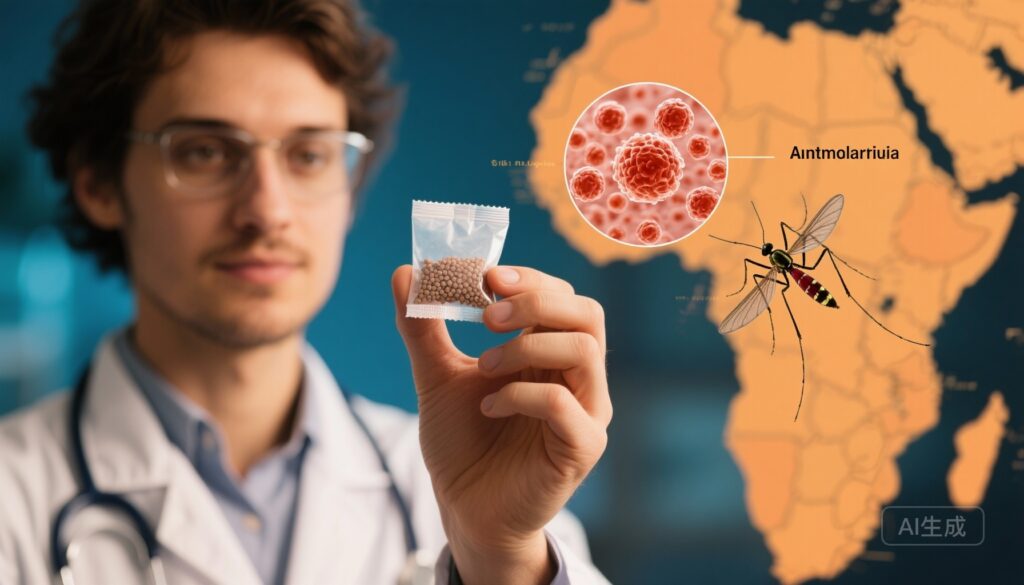Highlights
• The KALUMA Phase III trial of KLU156 (ganaplacide‑lumefantrine, “GanLum”) met its primary non‑inferiority endpoint versus Coartem® (artemether‑lumefantrine), reporting a PCR‑corrected Day‑29 cure rate of 97.4% using an estimand framework (99.2% by per‑protocol analysis).
• GanLum combines a novel non‑artemisinin compound, ganaplacide (an imidazolopiperazine targeting the parasite secretory pathway), with a once‑daily formulation of lumefantrine; it showed activity against mutant parasites associated with partial artemisinin resistance and rapid effect on mature gametocytes.
• Safety was reported as similar to standard of care; next steps include regulatory review, WHO engagement, and post‑approval surveillance for efficacy and resistance.
Background and disease burden
Malaria remains a major global health problem. Plasmodium falciparum causes the most severe disease and is responsible for most malaria deaths, particularly in sub‑Saharan Africa and among children under five. Despite progress over recent decades, the emergence and spread of partial resistance to artemisinin derivatives and partner drugs threaten gains in malaria control (see Rosenthal 2024). New therapeutic options with novel mechanisms of action are therefore a public health priority.
Study design and methods
The pivotal KALUMA (KLU156) study was a Phase III, randomized, open‑label, multicenter non‑inferiority trial comparing GanLum (ganaplacide‑lumefantrine) with the current standard of care Coartem® (artemether‑lumefantrine). Trial conduct took place across 34 sites in 12 sub‑Saharan African countries. The trial population comprised adults and children with acute, uncomplicated P. falciparum malaria; the KALUMA description specifies enrollment of 1,668 participants ≥10 kg, while a Novartis statement also cited 1,688 participants across sites.
Interventions: GanLum was administered as a once‑daily sachet of granules for three days (ganaplacide + a new once‑daily lumefantrine formulation). The comparator was artemether‑lumefantrine per standard dosing.
Primary endpoint: PCR‑corrected adequate clinical and parasitological response (ACPR) at Day 29. The primary analysis used an estimand framework: a conservative regulatory‑oriented approach that treats patients who discontinue or have missing PCR data at the analysis timepoint as treatment failures. A conventional per‑protocol analysis (excluding such patients) was also performed post hoc for comparability with historical antimalarial trials.
Key findings
Efficacy
Using the estimand approach, GanLum achieved a PCR‑corrected Day‑29 ACPR of 97.4% compared with 94.0% for the standard of care (artemether‑lumefantrine). When analyzed by a conventional per‑protocol method (post hoc), cure rates were 99.2% for GanLum and 96.7% for Coartem®.
Uncorrected ACPR at Day 29 (which does not distinguish recrudescence from new infections) was 85.3% for GanLum versus 82.1% for the comparator. The difference between PCR‑corrected and uncorrected results reflects the high reinfection pressure in endemic settings and underscores the importance of molecular correction for assessing intrinsic drug efficacy.
Subgroup and molecular analyses reported in the trial indicate high efficacy against parasite strains carrying mutations associated with partial artemisinin resistance. Additional in‑trial assessments suggested a rapid effect on mature gametocytes, the sexual stage responsible for transmission to mosquitoes; this raises the possibility of transmission‑blocking benefits, though field transmission studies will be needed to quantify impact.
Safety and tolerability
Overall safety was reported as similar to the standard of care, with adverse events broadly consistent with acute malaria. Novartis reported no new safety signals in the trial. The open‑label design can influence reporting of subjective adverse events; detailed safety tables and longer follow‑up from regulatory submissions will be needed to fully characterize tolerability across age groups and special populations (for example, pregnant women and infants below enrollment thresholds).
Mechanism and preclinical rationale
Ganaplacide is a member of the imidazolopiperazine class and is thought to act by disrupting the parasite’s intracellular secretory pathway — interfering with protein trafficking and processes essential for survival within erythrocytes (LaMonte et al., 2020). This mechanism is distinct from artemisinin and partner drugs, providing biological plausibility for activity against drug‑resistant parasites. The compound emerged from a large phenotypic screen of millions of molecules and was advanced with MMV partnership and consortium funding.
Expert commentary and interpretation
Why the results matter: If regulatory authorities authorize GanLum, it would represent the first major new antimalarial class introduced since artemisinin‑based combination therapies (ACTs) became widely used in the late 1990s and early 2000s. The combination of a novel mechanism and a longer‑acting partner drug is a recognized strategy to both clear clinical infections and reduce the probability of selecting resistance.
Clinical significance: The 97.4% PCR‑corrected ACPR at Day 29 (estimand) and 99.2% per‑protocol cure rates compare favorably with historical ACT outcomes and suggest robust efficacy in high‑burden African settings. Rapid gametocytocidal activity is particularly notable because reducing transmissibility could have population‑level benefits beyond individual cure.
Limitations and open questions
• Open‑label design: The lack of blinding can affect subjective endpoints and adverse event ascertainment. Objective parasitological endpoints are less susceptible but still require careful interpretation.
• Follow‑up duration: A 29‑day primary endpoint is standard for many antimalarial trials, but longer follow‑up (e.g., 42 or 63 days) can better capture late recrudescence and partner‑drug failures, particularly for long‑acting drugs.
• Resistance risk and durability: Introduction of any new agent requires careful surveillance to detect emergent resistance. While ganaplacide targets a novel pathway, selective pressure and cross‑resistance mechanisms cannot be excluded and will need monitoring via molecular markers and therapeutic efficacy studies.
• Special populations: Data on pregnant women, infants below enrollment weight limits, and patients with severe malaria are lacking; targeted studies or registries will be required before routine use in these groups.
• Implementation considerations: Cost, manufacturing scale‑up, supply chain, and integration into national treatment guidelines will determine real‑world impact. Prior experience with Coartem® includes large volumes provided at no profit to public health programs; similar access commitments will be crucial for uptake.
Regulatory and public health implications
Novartis has signaled plans to pursue regulatory approvals and cited prior Fast Track and Orphan Drug Designations from the FDA (2022). If authorized, GanLum would need WHO prequalification and inclusion in WHO treatment guidelines for broad adoption in endemic countries. Post‑approval, pharmacovigilance, therapeutic efficacy monitoring, and pharmacokinetic‑pharmacodynamic evaluations in different populations will be essential.
Conclusion and practical takeaways
KLU156 (ganaplacide‑lumefantrine, GanLum) produced robust results in a large Phase III study, meeting its primary non‑inferiority endpoint and showing high PCR‑corrected Day‑29 cure rates. The combination offers a novel mechanism of action with a convenient once‑daily partner formulation and promising activity against strains with partial artemisinin resistance and against gametocytes. These findings, if confirmed in regulatory dossiers and post‑marketing surveillance, could meaningfully expand the therapeutic toolkit against P. falciparum in Africa and elsewhere.
For clinicians and public health programs: stay informed about regulatory outcomes, anticipate guidance from WHO and national malaria control programs, and prioritize integration of new therapies into resistance surveillance frameworks. Until broader approvals and guideline updates, current national treatment recommendations and local susceptibility patterns should guide therapy.
Funding and trial registration
The GanLum program and the KALUMA study were developed by Novartis with scientific and financial support from the Medicines for Malaria Venture (MMV) and within the WANECAM2 consortium, with funding from the European & Developing Countries Clinical Trials Partnership (EDCTP) and co‑funding partners. The KALUMA study identifier is NCT05842954 as reported in trial documentation.
References
1. Rosenthal PJ. The emergence of artemisinin partial resistance in Africa: how do we respond? Lancet Infect Dis. 2024;24(9):e591‑e600.
2. Winnips C, et al. KALUMA – A pivotal Phase III trial to evaluate the efficacy, safety and tolerability of the novel anti‑malarial drug ganaplacide‑lumefantrine (KLU156) in uncomplicated malaria. Presented at: Annual Meeting of the American Society of Tropical Medicine and Hygiene; November 12, 2025.
3. LaMonte GM, et al. Pan‑active imidazolopiperazine antimalarials target the Plasmodium falciparum intracellular secretory pathway. Nat Commun. 2020 Apr 14;11(1):1780.
4. Brancucci NMB, et al. An all‑in‑one pipeline for the in vitro discovery and in vivo testing of Plasmodium falciparum malaria transmission blocking drugs. Nat Commun. 2025 Jul 25;16(1):6884.
5. Gal IR, et al. Drug Interaction Studies of Cabamiquine:Ganaplacide Combination against Hepatic Plasmodium berghei. ACS Infect Dis. 2025 Jan 10;11(1):69‑79.
6. Premji ZG. Coartem: the journey to the clinic. Malar J. 2009 Oct 12;8 Suppl 1(Suppl 1):S3.
7. WHO. World Malaria Report. (Access latest WHO malaria epidemiology reports and guidance.)
8. Access to Medicine Foundation. Access to Medicine Index 2024.
Further reading and monitoring
Clinicians and program managers should monitor peer‑reviewed publications and regulatory assessment reports for detailed safety tables, subgroup analyses, pharmacokinetics, and resistance marker data as they become available. Integration of new antimalarials into practice should be accompanied by robust surveillance and access planning to ensure maximal public health benefit.



